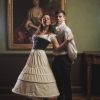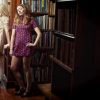
Costume exhibition opens at Killerton House
From a 150-year-old crinoline to a 60s mini, garments have shaped not only their owners but also the entire face of fashion. Killerton’s latest costume exhibition ‘The F-Word: the changing language of fashion’ opens on Saturday 14 February and explores how fashion has responded to the latest innovations and made its mark across the centuries.
Zips, buttons, elastic – items now taken for granted were revolutionary in their day. They changed what could be worn and also helped people dress faster and with ease. And the language of fashion is often bound to the technology and materials used to produce it.
The exhibition also explores how elements of clothing were named in the past, and how whalebone and then steel hoops, elastic, rubber and plastics transformed the way clothing works, and created fortunes for inventors and manufacturers.
‘The F-word’ draws on the wealth of the costume collection at Killerton, and uses special items to tell the story of how and why fashion has evolved over the years. The collection has grown over time, and now includes men’s, women’s and children’s clothing dating from 1690 to the 1970s.
Trousers have caused quite a stir in fashion. In the eighteenth century most upper-class men wore knee breeches, until they began to be replaced by a version of the long work pants of the working classes. Only in the 1880s did women start to wear trousers or ‘bifurcated’ garments – either hidden under a skirt when riding or for practical cycling, when divided skirts or bloomers might be worn. It wasn’t until the 1970s that trousers finally won a secure place in women’s fashion.
Rare treats in the exhibition include…
• Man’s coat, made of silk woven with metallic thread in about 1690
• Jacquard woven silk afternoon dress, about 1860, highlighting advances in silk weaving (the Jacquard looms, with punched cards controlling the pattern weaving, inspired Charles Babbage who came up with the idea for the first computer)
• Woollen wedding dress, knitted on a domestic knitting machine in1971, when the trend for home knitting machines was at its peak
• Mini dress made of Crimplene (one of the new synthetic fabrics) in a bright psychedelic print. Minis were at their shortest by about 1969
• Elegant mini and jacket by Emanuel Ungaro, about 1966
• Gold nylon and lurex ballgown by Maryon, late 1940s. Nylon and lurex were new man-made fibres developed in the 1930s.
The exhibition also highlights methods of pattern-cutting and decorative techniques, and fabrics and clothing that were revolutionary in their time. The first water-powered mills, rotary printers and synthetic dyes and materials eased what was a cottage industry into the world of mass production and fashion for all.
This year, the exhibition showcases new work from an open competition for designers, with their garments on display alongside historic pieces from Killerton’s renowned fashion collection.
For the competition, amateur and professional designers of all ages submitted new designs and work on the theme of innovation.
Killerton’s costume curator Shelley Tobin said: “Throughout history, fashion has not only reflected social and technological changes, but also led the way. Drawing on the unique costume collection at Killerton we are bringing the changing language of fashion to life.
“With London Fashion Week and a new fashion season upon us, it's fantastic to have this opportunity to exhibit new work by designers of the future alongside these historic pieces. Maybe we’ll get a glimpse of fashions to come.”
For more information visit www.nationaltrust.org.uk/killerton or telephone 01392 881345.


















